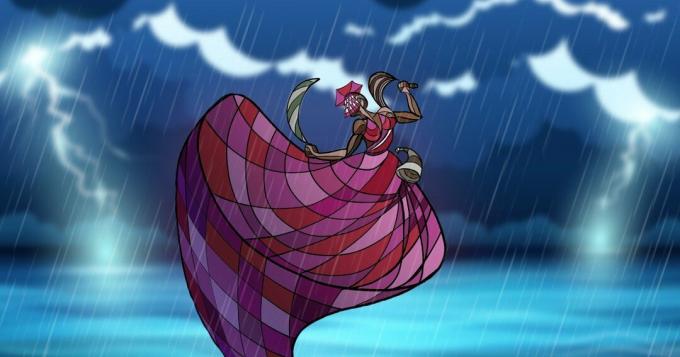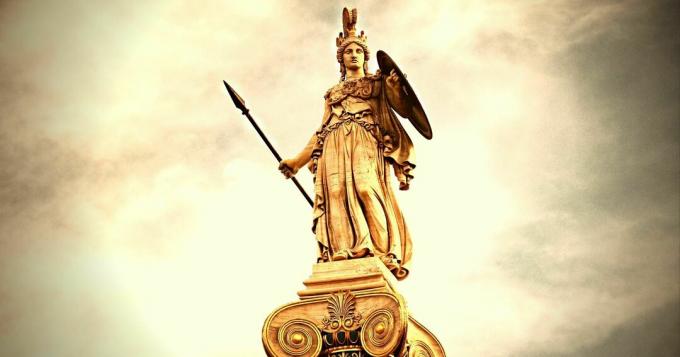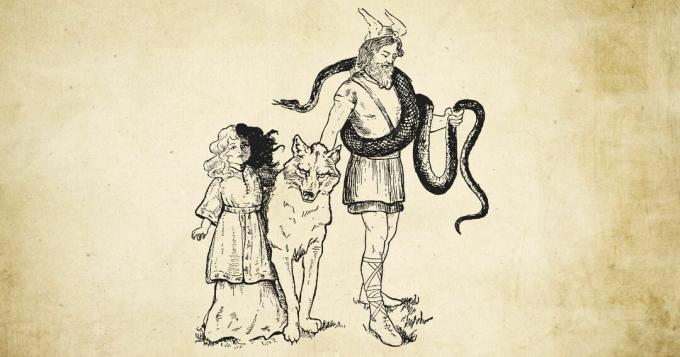Iansã is a divinity of religions afro-brazilian and mythology Yoruba associated with winds and the waters. Also known as hello or Oya, is one of the main female orishas.
She is widely worshiped and celebrated in various religious traditions in Brazil, West Africa and Central America. Her importance transcends the borders of religion, extending to Afro-Brazilian culture and identity.

History, meaning and syncretism
Originating from the people who occupied the sub-Saharan territory today corresponding to Nigeria, Togo and Sierra Leone, the goddess is part of the yoruba pantheon, a rich religious tradition that encompasses several deities associated with aspects of nature and human life.
According to this mythology, Iansã is daughter of Iemanjá and Oxalá, and has as brothers Oxum, Obá and Oxossi.
Obstinate and courageous goddess, she has two husbands: Ogun, the hunter, and Xango, the lord of fire. With her two husbands, she approached the battles, becoming a iabá (female orixá) associated with war.
Your name, Oya, emerged from a river in Nigeria where his cult originated, currently called Niger river. the nomenclature Iansã, in turn, means "mother of the rosy sky" or "mother of the evening". Xangô, called her that way, because he considered her radiant as the evening.
Over the centuries, the Yoruba religion was brought to Brazil by enslaved Africans, who maintained their religious beliefs and practices even under the yoke of oppression.
In the context of the African diaspora, a process of religious syncretism, in which Yoruba deities were associated with Catholic saints, seeking to preserve their traditions in disguise.
In this context, Iansã was assimilated to the figure of Santa Barbara, resulting in a fusion of symbols and rituals.
Characteristics of Iansã
Oiá is an iabá related, above all, to the element air. It has the power to control and direct the winds, bringing about changes and transformations. Your storms represent your ability to purify and renew.
The goddess is also associated with lightning and thunder. Lightning is seen as her weapon, a symbol of her destructive power, but also of her relentless justice. Thunder announces her presence and intensifies her energy.
Iansã is considered a protector, both in everyday life and in the spiritual and emotional fields. According to tradition, she defends her followers against negative influences, bringing security and balance. Your protective energy is often invoked to ward off dangers and offer shelter.
She is also linked to the cult of the dead. According to mythology, the goddess received from Obaluaiê the responsibility of guiding the souls of the deceased (eguns) to one of the nine heavens, according to her actions in life. To protect herself from these spirits, she received from Oxossi a eruexin (kind of feather duster made with animal tail hair).
Iemanjá in Candomblé and Umbanda
The goddess of the Niger River is worshiped in Brazil by religions of African origin, especially in candomblé and on umbanda. Although there are some differences in their cults, both traditions recognize Iansã as an orixá of great importance and power.
Both in Candomblé and Umbanda, the cult of Iansã is marked by reverence, respect and the search for its transforming energy. She is seen as a warrior deity that brings courage, protection and direction in times of challenges.
Iansã day
Iansã is celebrated in December 4th, which is also the date dedicated to Santa Bárbara of Catholicism, with whom she is syncretized. Furthermore, it is in Wednesdays that she usually receives tributes, this being the day of the week specially dedicated to her.
Children of Iansã
The sons and daughters of Iansã are audacious and powerful people, who count on the help of the goddess to face life's challenges. They are fighters, express sensuality and can manifest jealousy in their relationships. They are intelligent, intense and have difficulty controlling their emotional impulses.
Oiá is a protective deity, who guards her sons and daughters from the storms of life. She takes care of women working in trade, in addition to offering protection to female leaders. As an independent and free entity, it guides its followers along the path of freedom.
Greetings, colors, offerings, animals and symbols of Iansã
- Salutation: Epaheyy, Oyá! ("Hello, Iansã!")
- Colors: pink, brown, red and white.
- Offerings (ebós) indicated: abará, acarajé and goats.
- Prohibited offerings (ebós): pumpkin, stingray meat and lamb.
- Animals: butterfly and buffalo, which refer to the freedom, lightness and strength characteristic of Iansã
- Symbols: eruexuim (or iruquerê) and the copper sword.
Bibliography
- DOGUN, William. Ballet Iansã: lady of the eguns. Rio de Janeiro: Pallas, 2007.
- PRANDI, Reginald. Mythology of the Orixás. São Paulo: Companhia das Letras, 2001.
See too:
- Candomblé and Umbanda
- Ogun
- Yemanja
- Xango
- oxum



